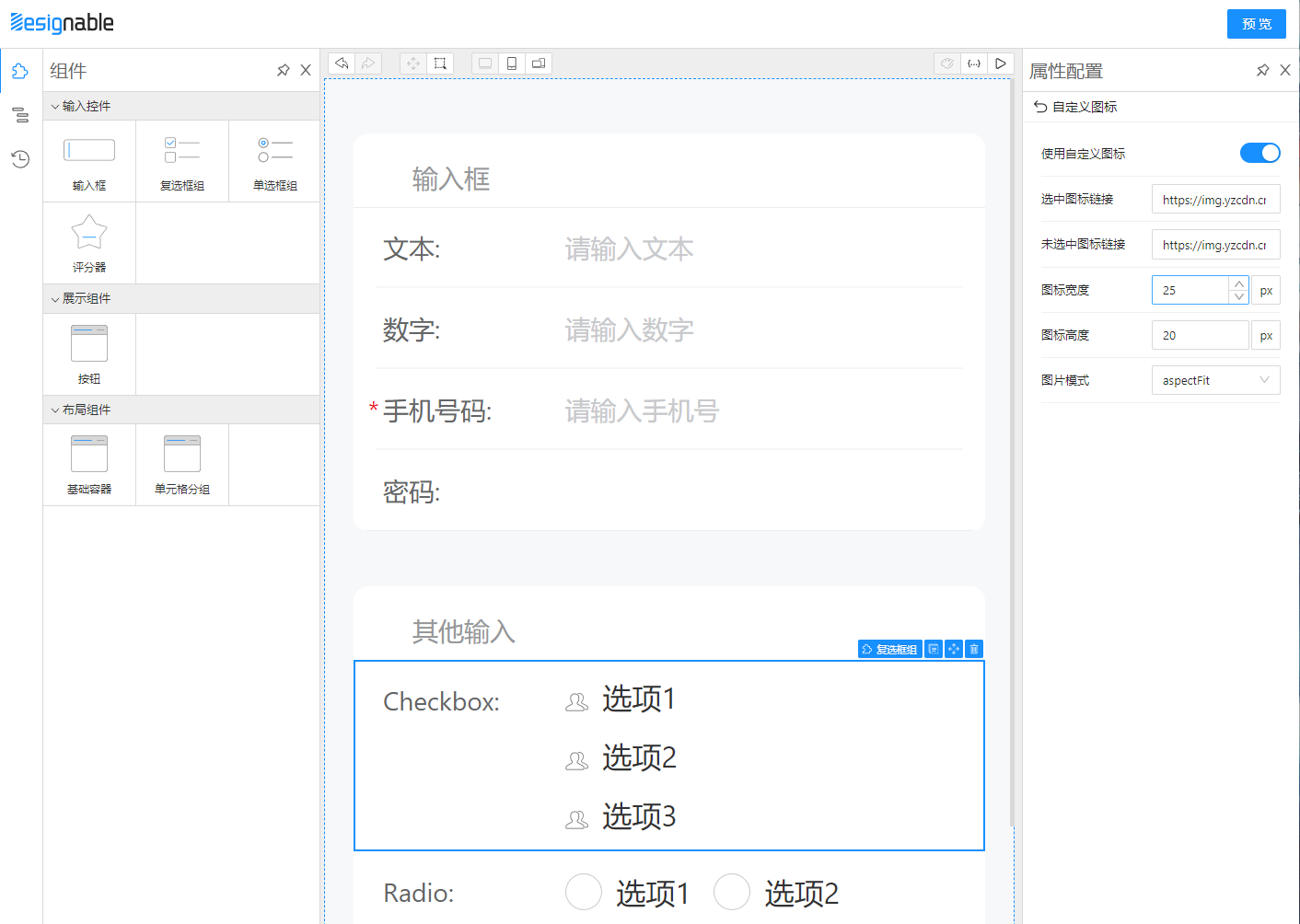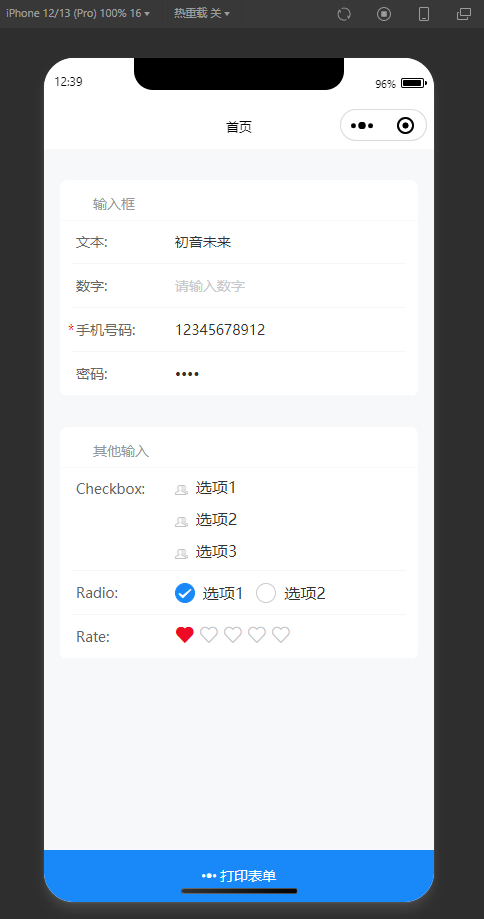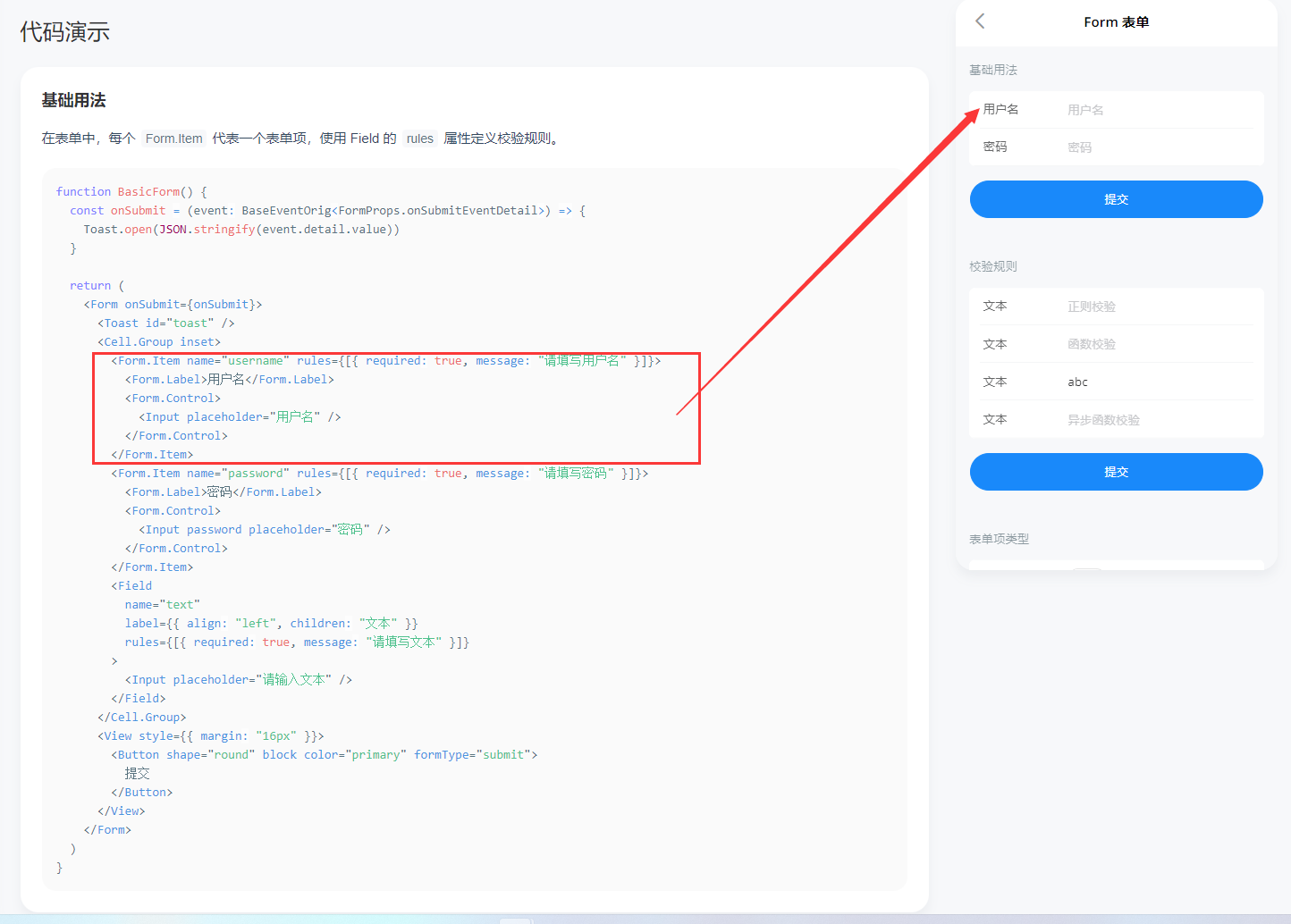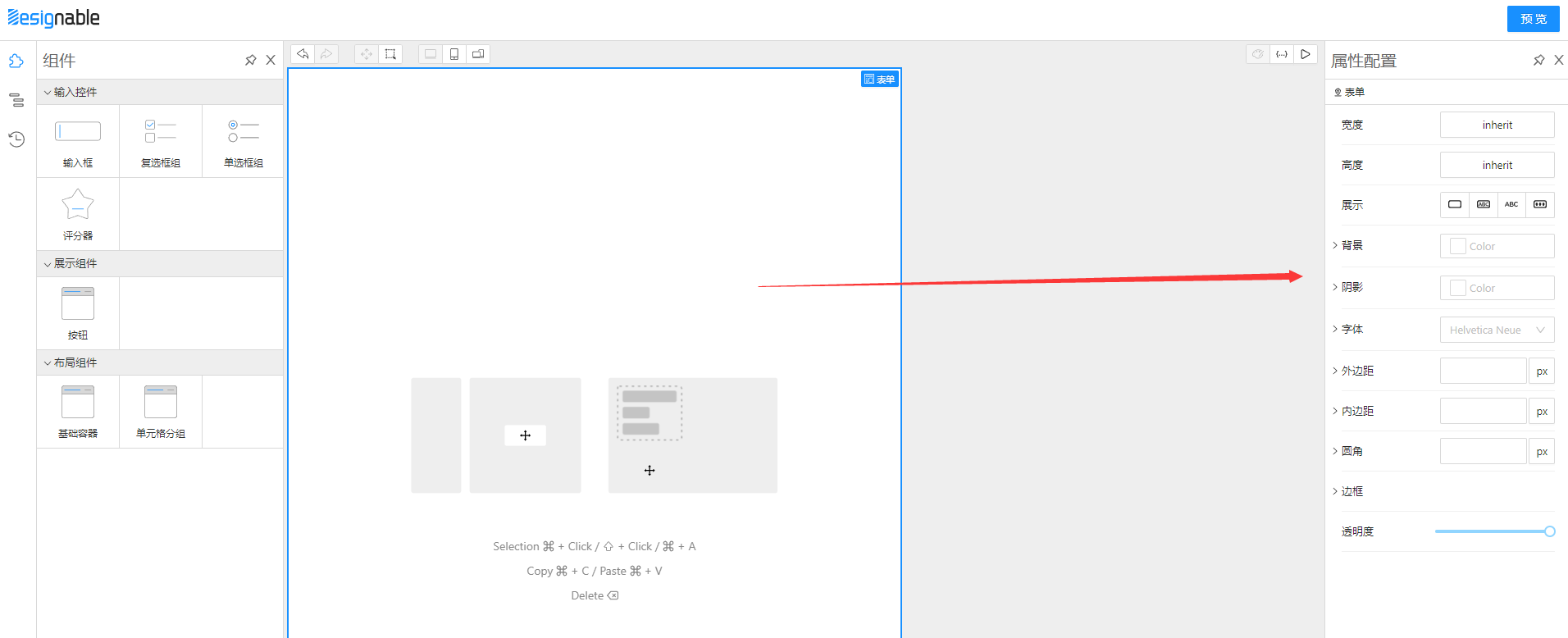开搞开搞
可视化设计器(体积很大,注意流量,最好用PC打开) https://miku01.cn/taroifyDesignable/index.html
demo H5(按 F12 切换设备仿真) https://miku01.cn/taroifyDemo/index.html#/pages/index/index
我们需要挑一个称手的Taro组件库
目前京东出的组件库中 taro-ui 没什么更新了,NutUI只支持 Vue 不支持 React,所以选择了个人开发的 taroify,由于是从 vant 改来的,所以颜值也比较高,文档地址
Form组件是地基,接收一个Form实例,渲染children内容。
@formily/antd 中一个简单的示例如下
import React from 'react'
import { Input,Form,FormItem,Submit, } from '@formily/antd'
import { createForm } from '@formily/core'
import { Field } from '@formily/react'
const form = createForm()
export default () => (
<Form
form={form}
layout="vertical"
feedbackLayout="terse"
onAutoSubmit={console.log}
onAutoSubmitFailed={console.log}
>
<Field
name="bb"
title="输入框"
required
decorator={[FormItem]}
component={[Input]}
/>
</Form>
)根据 @formily/antd 的代码,照猫画虎出属于我们的Form组件,除了formily提供的能力外就是一个Taro的View组件
import React, { createContext, useContext } from 'react'
import { Form as FormType, ObjectField } from '@formily/core'
import {
ExpressionScope,
FormProvider,
JSXComponent,
useParentForm,
} from '@formily/react'
import { View as TaroView } from '@tarojs/components'
import { PreviewText } from '../PreviewText'
const View: any = TaroView // 这是为了处理类型报错,请不要在意
export interface IFormLayoutProps {
form?: FormType
component?: JSXComponent
previewTextPlaceholder?: React.ReactNode
className?: string
style?: React.CSSProperties
}
export const Form: React.FC<React.PropsWithChildren<IFormLayoutProps>> = ({
form,
component,
previewTextPlaceholder,
className,
style,
children
}) => {
const top = useParentForm() // 获取父表单 现在并不重要
// 重要的是这里 我们的Form组件就简单的用Taro的View组件包住子组件渲染
// ExpressionScope是用context来给 json-schema 表达式传递局部作用域,我们可以用它当做数据源
// PreviewText.Placeholder也是一个context 给预览态显示文本一个缺省值,目前也不重要
const renderContent = (_form: FormType | ObjectField) => (
<ExpressionScope value={{ $$form: _form }}>
<PreviewText.Placeholder value={previewTextPlaceholder}>
<View className={className} style={style}>
{children}
</View>
</PreviewText.Placeholder>
</ExpressionScope>
)
if (form)
// 最重要的是这里,有FormProvider才能提供MVVM能力,进行微操
return <FormProvider form={form}>{renderContent(form)}</FormProvider>
if (!top) throw new Error('must pass form instance by createForm')
return renderContent(top)
}
Form.defaultProps = {
component: 'form',
}
export default Form如图所见FormItem的作用就是显示label、必填、校验文案等,并且让表单布局更加美观,我们需要混入Formily能力。
首先介绍 pickDataProps 方法,这个方法主要挑选出 @designable/react ComponentTreeWidget 渲染器给的属性,在设计器中这些属性挂在dom上才能点击选中、拖拉拽。
export const pickDataProps = (props: any = {}) => {
const results = {}
for (const key in props) {
if (key.indexOf('data-') > -1) {
results[key] = props[key]
}
}
return results
}接着我们改造一下FormItem的最外层,要让designable属性能够挂到dom上,并且阉割掉原来UI库有关Form的功能,化为己用。
<CellBase {...pickDataProps(_props)} 这段代码就是处理designable属性的
// fork for supporting designable props
import * as React from 'react'
import {
Children,
isValidElement,
ReactElement,
ReactNode,
useMemo,
} from 'react'
import { CellBase, CellProps, CellValue } from '@taroify/core/cell'
import Form from '@taroify/core/form'
import { prefixClassname } from '@taroify/core/styles'
import { isElementOf } from '@taroify/core/utils/validate'
import { cloneIconElement } from '@taroify/icons/utils'
import { View as _View } from '@tarojs/components'
import { InputProps } from '@tarojs/components/types/Input'
import classNames from 'classnames'
import * as _ from 'lodash'
import { pickDataProps } from '../components/__builtins__'
const View: any = _View
export interface FormItemProps extends CellProps {
name?: string
defaultValue?: any
required?: boolean
children?: ReactNode
}
interface FormItemChildren {
label?: ReactElement
control?: ReactElement
feedbacks?: ReactElement[]
}
function useFormItemChildren(children?: ReactNode): FormItemChildren {
return useMemo<FormItemChildren>(() => {
const __children__: FormItemChildren = {
feedbacks: [],
}
Children.forEach(children, (child: ReactNode) => {
if (!isValidElement(child)) {
return
}
const element = child as ReactElement
const { type: elementType } = element as ReactElement<InputProps>
if (isElementOf(element, Form.Label)) {
__children__.label = element
} else if (elementType === Form.Control) {
__children__.control = element
} else if (isElementOf(element, Form.Feedback)) {
__children__.feedbacks?.push(element)
}
})
return __children__
}, [children])
}
const FormItem = (props: FormItemProps) => {
const {
className,
style,
name,
defaultValue,
align,
bordered,
icon,
rightIcon,
clickable,
required,
children: childrenProp,
onClick,
..._props
} = props
const { label, control, feedbacks } = useFormItemChildren(childrenProp)
const explain = useMemo(
() => !_.isEmpty(feedbacks),
[feedbacks]
)
return (
<CellBase
{...pickDataProps(_props)}
className={classNames(prefixClassname('form-item'), className)}
style={style}
bordered={bordered}
align={align}
clickable={clickable}
icon={cloneIconElement(icon, {
className: prefixClassname('form-item__icon'),
})}
rightIcon={cloneIconElement(rightIcon, {
className: prefixClassname('form-item__right-icon'),
})}
required={required}
onClick={onClick}
>
{label}
<CellValue alone={false}>
{control}
{explain && (
<View className={classNames(prefixClassname('form__feedbacks'))}>
{feedbacks}
</View>
)}
</CellValue>
</CellBase>
)
}
export default FormItem最后封装出我们自己的 FormItem,让它可以只根据最外层的props就能发挥出最大功能。这里我们先提供简单的对齐方式配置、冒号配置,同时我们需要用 mapProps 去映射校验文案字段。
/* eslint-disable react/no-children-prop */
import React from 'react'
import { GeneralField, isVoidField } from '@formily/core'
import { connect, mapProps } from '@formily/react'
import { Field, Form } from '@taroify/core'
import { createVariantElement } from '@taroify/core/utils/element'
import { View as TaroView } from '@tarojs/components'
import classNames from 'classnames'
import FormItemBase from '../../ui/form-item'
import { pickDataProps } from '../__builtins__'
const View: any = TaroView
export interface IFormItemProps {
className?: string
style?: React.CSSProperties
field: GeneralField
colon: boolean // 是否有冒号
labelAlign?: 'left' | 'center' | 'right' // label对齐方式
wrapperAlign?: 'left' | 'center' | 'right' // 组件对齐方式
feedbackStatus?: 'error' | 'warning' | 'success' | 'pending'
[propName: string]: any
}
export const BaseItem: React.FC<React.PropsWithChildren<IFormItemProps>> = ({
className,
style,
children,
field,
colon = true,
labelAlign = 'left',
wrapperAlign = 'left',
feedbackStatus,
feedbackText,
...props
}) => {
const required =
!isVoidField(field) && field.required && field.pattern !== 'readPretty'
return (
<FormItemBase
required={required}
bordered
className={className}
style={style}
{...pickDataProps(props)}
>
<Form.Label align={labelAlign} colon={colon}>
{field.title}
</Form.Label>
{children && <Form.Control children={children} align={wrapperAlign} />}
{feedbackStatus !== 'pending' && (
<Form.Feedback
status={
feedbackStatus === 'success'
? 'valid'
: feedbackStatus === 'error'
? 'invalid'
: 'warning'
}
>
{feedbackText}
</Form.Feedback>
)}
</FormItemBase>
)
}
export const FormItem = connect(
BaseItem,
mapProps((props, field) => {
if (isVoidField(field))
return {
...props,
field,
}
const takeFeedbackStatus = () => {
if (field.validating) return 'pending'
return field.decoratorProps.feedbackStatus || field.validateStatus
}
const takeMessage = () => {
const split = (messages: any[]) => {
return messages.reduce((buf, text, index) => {
if (!text) return buf
return index < messages.length - 1
? buf.concat([text, ', '])
: buf.concat([text])
}, [])
}
if (field.validating) return
if (props.feedbackText) return props.feedbackText
if (field.selfErrors.length) return split(field.selfErrors)
if (field.selfWarnings.length) return split(field.selfWarnings)
if (field.selfSuccesses.length) return split(field.selfSuccesses)
}
return {
...props,
field,
feedbackStatus: takeFeedbackStatus(),
feedbackText: takeMessage(),
}
})
)Input组件适配Formily代码如下
import React from 'react'
import { connect, mapProps, mapReadPretty } from '@formily/react'
import { Input as component } from '@taroify/core'
import { PreviewText } from '../PreviewText'
export const Input = connect(
component,
mapProps((props, field) => {
return {
...props
}
}),
mapReadPretty(PreviewText.Input)
)是不是灰常简单
最后我们用 createSchemaField 包一层,生成属于 taroify 的渲染器
import { createSchemaField } from '@formily/react'
import {
Button,
CellGroup,
Checkbox,
DatetimePicker,
FormItem,
Input,
Radio,
Rate,
Slider,
Stepper,
Switch,
WidgetBase,
} from './index'
export const SchemaField = createSchemaField({
components: {
Button,
CellGroup,
Checkbox,
DatetimePicker,
FormItem,
Input,
Radio,
Rate,
Slider,
Stepper,
Switch,
WidgetBase,
},
})组件库准备好了之后,我们可以选择用 rollup 打包,也可以选择在项目中直接使用 tsx 文件。
由于 Taro 跨端的特性,让组件库在 h5 环境下展示是一定可以的,不过有两种方案:
- 用完整的Taro项目,接入部分designable能力,最后以iframe的形式嵌入PC设计器中
- PC设计器营造
h5端的氛围,让Taro组件直接展示,不经过@tarojs/cli打包
我选择了方案二,感觉比较简单,因为不需要跨iframe通信,而且觉得@tarojs/cli打包到h5比较慢(这里没有经过验证)。
那么如何营造 Taro h5 氛围呢?
首先 @tarojs/components 使⽤了 Stencil 去实现了⼀个基于 WebComponents 且遵循微信⼩程序规范的组件库,用 reactify-wc 让React项目中能够使用 WebComponent,stenciljs 打包的组件产物中有 defineCustomElements,调用一下才可以把 WebComponents 注册到浏览器中
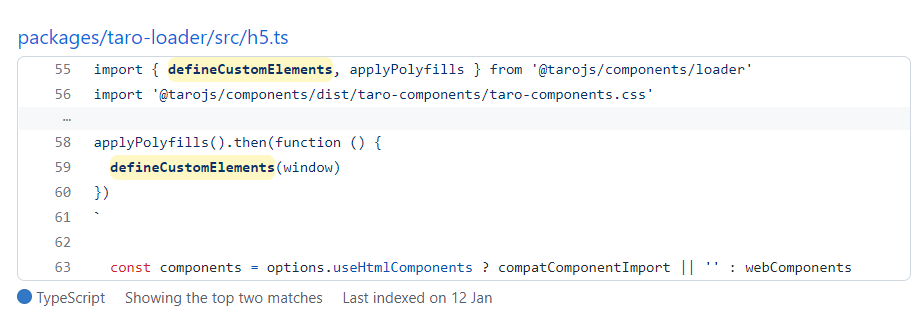
在设计器 main.tsx 中
import { defineCustomElements } from '@tarojs/components/dist/esm/loader.js'
import '@tarojs/components/dist/taro-components/taro-components.css'
defineCustomElements(window)接着webpack配置还要处理两个地方
export default {
resolve: {
modules: ['node_modules'],
extensions: ['.js', '.jsx', '.ts', '.tsx', '.json'],
alias: {
'@tarojs/components$': '@tarojs/components/dist-h5/react',
'@tarojs/taro': '@tarojs/taro-h5',
},
},
module: {
rules: [
{
test: /taro-h5[\\/]dist[\\/]index/,
loader: require.resolve(
'@tarojs/plugin-framework-react/dist/api-loader.js'
),
},
...
],
},
...
}这样就可以获得一个残缺的 Taro h5 React 环境,会有一些api不支持,比如路由跳转。
要开始使用 taroify-formily,还得先引入它的爸爸 taroify 组件库的样式
import '@taroify/icons/index.scss'
import '@taroify/core/index.scss'组件封装物料,主要是添加 Behavior 和 createResource,重点还是 Behavior
Form组件处理,Behavior 中的 propsSchema 就是最主要的部分,type 定义了Form组件绑定的是对象字段模型,properties 中定义了 style 需要编辑。
我们看看 style 有些什么东西,以下代码展示了 style 的各个字段可以用 Select、SizeInput、BackgroundStyleSetter 等 designable 提供的配置器去配置属性,由 x-component 指定
import { ISchema } from '@formily/react'
export const CSSStyle: ISchema = {
type: 'void',
properties: {
'style.position': {
type: 'string',
'x-decorator': 'FormItem',
default: 'relative',
'x-component': 'Select',
enum: [
{ label: 'static', value: 'static' },
{ label: 'relative', value: 'relative' },
{ label: 'absolute', value: 'absolute' },
{ label: 'fixed', value: 'fixed' },
{ label: 'sticky', value: 'sticky' },
],
},
'style.top': {
type: 'string',
'x-decorator': 'FormItem',
'x-component': 'SizeInput',
default: '0px',
},
'style.left': {
type: 'string',
'x-decorator': 'FormItem',
'x-component': 'SizeInput',
default: '0px',
},
'style.right': {
type: 'string',
'x-decorator': 'FormItem',
'x-component': 'SizeInput',
default: '0px',
},
'style.bottom': {
type: 'string',
'x-decorator': 'FormItem',
'x-component': 'SizeInput',
default: '0px',
},
'style.width': {
type: 'string',
'x-decorator': 'FormItem',
'x-component': 'SizeInput',
},
'style.height': {
type: 'string',
'x-decorator': 'FormItem',
'x-component': 'SizeInput',
},
'style.display': {
'x-component': 'DisplayStyleSetter',
},
'style.background': {
'x-component': 'BackgroundStyleSetter',
},
'style.boxShadow': {
'x-component': 'BoxShadowStyleSetter',
},
'style.font': {
'x-component': 'FontStyleSetter',
},
'style.margin': {
'x-component': 'BoxStyleSetter',
},
'style.padding': {
'x-component': 'BoxStyleSetter',
},
'style.borderRadius': {
'x-component': 'BorderRadiusStyleSetter',
},
'style.border': {
'x-component': 'BorderStyleSetter',
},
'style.opacity': {
'x-decorator': 'FormItem',
'x-component': 'Slider',
'x-component-props': {
defaultValue: 1,
min: 0,
max: 1,
step: 0.01,
},
},
},
}import React, { useMemo } from 'react'
import { createBehavior, createResource } from '@designable/core'
import { DnFC, usePrefix } from '@designable/react'
import { createForm } from '@formily/core'
import { observer } from '@formily/react'
import * as lodash from 'lodash-es'
import { Form as FormilyForm } from 'taroify-formily/lib'
import { AllLocales } from '../../locales'
import { AllSchemas } from '../../schemas'
export const Form: DnFC<React.ComponentProps<typeof FormilyForm>> = observer(
(props) => {
const form = useMemo(
() =>
createForm({
designable: true,
}),
[]
)
return (
<FormilyForm
{...props}
form={form}
>
{props.children}
</FormilyForm>
)
}
)
Form.Behavior = createBehavior({
name: 'Form',
selector: (node) => node.componentName === 'Form',
designerProps(node) {
return {
draggable: !node.isRoot,
cloneable: !node.isRoot,
deletable: !node.isRoot,
droppable: true,
propsSchema: {
type: 'object',
properties: {
style: {
type: 'void',
properties: lodash.omit(AllSchemas.CSSStyle.properties as object, ['style.position', 'style.top', 'style.left', 'style.right', 'style.bottom'])
},
},
},
defaultProps: {
},
}
},
designerLocales: AllLocales.Form,
})
Form.Resource = createResource({
title: { 'zh-CN': '表单' },
icon: 'FormLayoutSource',
elements: [
{
componentName: 'Field',
props: {
type: 'object',
'x-component': 'Form',
},
},
],
})so,表单组件在 designable 中有一些样式可以配置
为什么跳过了 FormItem 呢,因为它是角色是其他组件的装饰器,它的属性在装饰目标组件上配置就可以了
Input组件处理
import React from 'react'
import { createBehavior, createResource } from '@designable/core'
import { DnFC } from '@designable/react'
import { Input as component } from 'taroify-formily/lib'
import { AllLocales } from '../../locales'
import { AllSchemas } from '../../schemas'
import { createFieldSchema } from '../Field'
export const Input: DnFC<React.ComponentProps<typeof component>> = component
const propsSchema = createFieldSchema({
component: AllSchemas.Input,
props: {
'component-events-group': []
}
}) as any
Input.Behavior = createBehavior(
{
name: 'Input',
extends: ['Field'],
selector: (node) => node.props['x-component'] === 'Input',
designerProps: {
propsSchema,
defaultProps: {
},
},
designerLocales: AllLocales.Input
},
)
Input.Resource = createResource(
{
icon: 'InputSource',
elements: [
{
componentName: 'Field',
props: {
type: 'string',
title: 'Input',
'x-decorator': 'FormItem',
'x-component': 'Input',
},
},
],
},
)createFieldSchema 中封装了很多field模型的行为,例如 title(label)、校验规则、联动逻辑等在 designable 中如何配置。提前介绍一下如何微操低代码页面
首先准备两个Input,一个叫a,一个叫b


hidden时隐藏


hidden,b输入框就会神奇的消失了
准备预览运行面板,使用 Form组件 和 SchemaField组件 提供运行时渲染能力,与实际消费端的区别是需要用 designable 提供的 transformToSchema 把拖拉拽面板中的组件树转成JSON协议。
import React, { useMemo } from 'react'
import { transformToSchema } from '@designable/formily-transformer'
import { createForm } from '@formily/core'
import { createSchemaField, FormProvider } from '@formily/react'
import {
CellGroup,
Form,
FormItem,
Input,
SchemaField,
WidgetBase,
} from 'taroify-formily/lib'
export interface IPreviewWidgetProps {
tree: any
}
export const PreviewWidget: React.FC<IPreviewWidgetProps> = (props) => {
const form = useMemo(() => createForm(), [])
const { form: formProps, schema } = transformToSchema(props.tree)
return (
<Form {...formProps} form={form}>
<SchemaField schema={schema} />
</Form>
)
}designable main.tsx处理。主要有 CompositePanel、WorkspacePanel、SettingsPanel 三大区域。
CompositePanel区域我们只需要把物料放入ResourceWidget中即可。
WorkspacePanel放了三个ViewPanel,分别是拖拉拽面板、JSON编辑面板、预览运行时渲染面板,我们需要把物料放入拖拉拽面板中再次注册一下,需要把 预览运行时组件塞进
const App = () => {
const engine = useMemo(
() =>
createDesigner({
rootComponentName: 'Form',
}),
[]
)
return (
<Designer engine={engine}>
<Workbench>
<StudioPanel logo={<Logo />} actions={<Actions />}>
<CompositePanel>
<CompositePanel.Item title="panels.Component" icon="Component">
<ResourceWidget
title="sources.Inputs"
sources={[Input, Checkbox, Radio, Rate]}
/>
<ResourceWidget title="sources.Displays" sources={[Button]} />
<ResourceWidget
title="sources.Layouts"
sources={[WidgetBase, CellGroup]}
/>
</CompositePanel.Item>
<CompositePanel.Item title="panels.OutlinedTree" icon="Outline">
<OutlineTreeWidget />
</CompositePanel.Item>
<CompositePanel.Item title="panels.History" icon="History">
<HistoryWidget />
</CompositePanel.Item>
</CompositePanel>
<WorkspacePanel> //工作区域
<ToolbarPanel>
<DesignerToolsWidget />
<ViewToolsWidget use={['DESIGNABLE', 'JSONTREE', 'PREVIEW']} />
</ToolbarPanel>
<ViewportPanel
style={{ minHeight: '100%', width: '750px', overflow: 'auto' }}
>
<ViewPanel type="DESIGNABLE">
{() => (
<ComponentTreeWidget
components={{
Button,
CellGroup,
Checkbox,
Form,
Field,
Input,
Radio,
Rate,
WidgetBase,
}}
/>
)}
</ViewPanel>
<ViewPanel type="JSONTREE" scrollable={false}>
{(tree, onChange) => (
<SchemaEditorWidget tree={tree} onChange={onChange} />
)}
</ViewPanel>
<ViewPanel type="PREVIEW">
{(tree) => <PreviewWidget tree={tree} />}
</ViewPanel>
</ViewportPanel>
</WorkspacePanel>
<SettingsPanel title="panels.PropertySettings">
<SettingsForm uploadAction="https://www.mocky.io/v2/5cc8019d300000980a055e76" />
</SettingsPanel>
</StudioPanel>
</Workbench>
</Designer>
)
}
ReactDOM.render(<App />, document.getElementById('root'))到这里前端页面可视化搭建系统的第一步已经迈出来,有了基本的组件库、协议和渲染器,并且在设计器中可以配置组件属性最终渲染界面,下篇文章再介绍如何让 小程序 和 H5 渲染设计器产出的JSONSchema。
